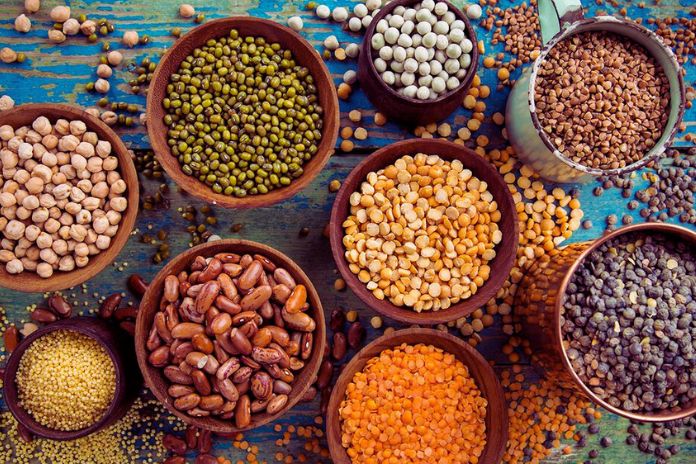Legumes are a source of vegetable protein and complex carbohydrates, they have many benefits for the body, but there are some side effects. Legumes are the seeds of leguminous plants, in special cases called pods. They have many interesting properties that differentiate them from vegetables, so they are considered a food class in their own right.
There are different types of legumes. The most common are beans, broad beans, peas, lentils, chickpeas, soybeans, lupins, carob beans, and peanuts (which therefore do not fall into the dried fruit category). Thanks to the ease of cultivation, these foods are easily available worldwide. From a nutritional point of view, they are among the most complete and richest elements available.
Legumes contain fiber, minerals, many B vitamins, trace elements, iron, zinc, and calcium. They are, therefore, a good energy source, contain few calories, help growth, and have excellent nutritional values. So let’s see the benefits and contraindications of these important foods.
Legumes: All The Nutritional Properties
Legumes are mainly composed of proteins and carbohydrates. Therefore, they provide slow-release energy and material for constructing new cellular structures. This differentiates them significantly from vegetables and greens. It should be emphasized that soybeans and peanuts have a higher lipid content than other legumes, almost devoid of lipids.
With their high amount of protein, legumes can almost reach the levels contained in foods of animal origin, such as fish, eggs, dairy products, and meat, and can therefore replace them, at least in part, in the diet. However, legumes must be combined with cereals, especially whole grains, to be equally effective and complete.
This is because legumes are poor in essential amino acids, of which cereals are rich. Dishes such as rice and peas, couscous and lentils, and pasta and beans are, therefore, perfect from a nutritional point of view. Conversely, they should not be associated with other protein sources because they would compromise the absorption of nutrients.
What Benefits Do Legumes Bring To Our Bodies?
Legumes are rich in antioxidants and help reduce the damage caused by free radicals. Furthermore, they are naturally cholesterol-free, contain very little fat, and are mainly unsaturated, therefore healthy for the heart and arteries. The high presence of iron means that regular consumption of legumes helps to counteract anemia and states of chronic weakness. Furthermore, thanks to the high concentration of fibers, they promote bowel regularity and help fight constipation.
Finally, they are gluten-free so that they can be eaten without risk by celiacs, even in the form of flour and pasta, and they promote a good mood thanks to the presence of tryptophan, from which serotonin, also called the hormone of happiness, is derived. In short, legumes are an ideal nutritional element for everyone, including pregnant women and children, during breastfeeding and weaning.
Legumes And Prevention: What Can They Help Us With?
Thanks to their various properties, legumes are useful for preventing and sometimes treating some pathologies and disorders of our bodies. Specifically, legumes are useful for fighting and preventing obesity, thanks to their high satiating power, low caloric intake, and low glycemic index, while they are rich in fiber and starch. They are also rich in saponin and lecithin, molecules useful in the fight against cholesterol.
For those with type II diabetes, legumes are an excellent nutrient because they are naturally free of simple sugars. As a result, they can lower blood sugar while ensuring the right body energy. Since they help to avoid the excessive absorption of cholesterol, sugars, and fats, legumes are also excellent for preventing cardiovascular problems and diseases.
It has also been shown that thanks to their micronutrient content (including phytic acid, saponins, and phenolic compounds), they help prevent cancer, especially those relating to the colon and digestive systems.
Contraindications: When Legumes Are Bad
Despite their multitudinous properties, vegetables additionally produce a few side outcomes. Some of these are not difficult to cure, yet you should be more cautious if you experience the ill effects of specific pathologies. The most popular secondary effect is meteorism because of how much non-absorbable supplements are in the digestive tract. From one perspective, this ensures the expansion of digestive bacterial greenery; conversely, it creates squandered substances like carbon dioxide and hydrogen.
To avoid this issue, it is prescribed to drench the vegetables for around 12 hours before cooking, wash them under running water, and cook them for quite a while along with a wise leaf, sound leaf, or fennel seeds. Vegetables can be hard to process since they have against supplement components, particularly in the strip. The most effective way to make them more edible is to mix them with a vegetable factory after cooking or consume the hulled ones. Then, at that point, there are obsessive circumstances in which taking legumes isn’t suggested. They ought to be generally kept away from in the event of gout, while those experiencing favism shouldn’t accept broad beans and peas.
Also Read: Cucumbers – Information, Tips, Calories, And Nutritional Values

